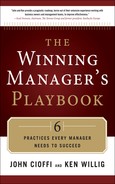Define the Position
It seems almost too easy to state that the first step in this process is to define the position. That’s what everyone already does, isn’t it? They determine that they need a salesperson, write some type of job description, and then go looking.
Unfortunately, a key part of the process that we’ve often found missing is the link between the company’s vision, goals, and strategies and the position being filled. All too often, companies simply replace a person who has left, or another salesperson is added to the existing structure, or a new management position is created when the group gets to a certain size. In other words, they lose sight of the big picture, the picture that tells them what they need to do today to get to where they want to be tomorrow.
This is actually quite understandable and, in many cases, seems to reflect common sense. It even echoes the cliché “If it ain’t broke, why fix it?” Why continually invent new positions when we already know what needs to be done? Why not add another salesperson when we’ve just seen our sales grow rapidly in the last two years? Why not add another manager when the group gets to twice the size of the other groups?
There are many examples illustrating how positions have been filled at the expense of the company’s future success—of losing sight of the big picture. There seem to be two major reasons for this.
In the first case, companies seem to be making a last-ditch effort in a losing cause. They continue to do what they’ve been doing, even though the future is sending them warning signals.
For example, in the early 2000s, there were many local video rental companies that continued to plan for the future as if it were still the late 1990s. They acted oblivious to their declining sales, due to the encroaching forces of firms that delivered movies and other entertainment by cable, phone lines, and satellite.
Similarly, logging firms have lobbied hard to have the right to cut the last 1 percent of old-growth timber in the country. What will they do after that? And Kodak continued to try to build its film business for years after the advent of digital imaging.
Our main point here is that it’s very easy to continue to do what you’ve always done. It worked in the past, and it requires little thought and expense. So, maybe you can ride the pony for just a little bit longer and then figure something out after that. Good luck.
In the second case, companies appear to be oblivious to their changing environment. Instead of ignoring some clear and obvious signals, they simply don’t see any signals.
In such cases, we believe that they fail to implement an effective planning process. They fail to collect and analyze information about their environment that would allow them to create successful strategies to fulfill their vision.
For example, a research division of the Xerox Company was responsible for inventing and developing some of the key innovations now commonly used on virtually all computers, but the company made virtually no effort to commercialize them. Xerox didn’t see the potential importance of these innovations, perhaps because it was focused on imaging rather than on computer technology.
Whatever the reason, these innovations apparently were not identified as opportunities (a key component of an effective planning process). Many years later, Xerox awoke to the commercial opportunities it had missed, and it sued Apple, who was implementing some of these technologies. But the statute of limitations had expired and the suit was unsuccessful. Too late.
Similarly, recyclers of newspapers might not immediately understand that their shrinking business was due to declining readership of papers, and attorneys might not understand that their business decline was due to the effectiveness of huge and effective advertising campaigns by a few large firms. All these companies are typically focused on the job at hand (the day-to-day activities of the business) rather than possible signals from the marketplace. As a consequence, they might continue to hire and plan as they had done in the past, only to be rudely awakened.
These examples illustrate that the position you seek to fill should be linked to your vision, strategies, and goals rather than to your day-to-day activities of the past. After you’ve engaged in an effective planning process, you will be able to identify the positions needed to carry out your strategies and attain your goals and vision.
Now you can look more closely at describing the position you seek to fill. We advise that you actually write out the requirements for the position, giving it the care and planning it deserves. After all, you’re going to be bringing someone new into the position, which has significant implications for that individual as well as others in your organization, for however long they remain.
There are several key components to an effective Position Description. At a minimum it should be clear and unambiguous, and it also should set clear expectations for the employee and the manager about the definition of success for the position (the goals).
On the following page is an example of a Position Description. We’ll explain some of this later when we talk about a management system for your company. For now, we’ll summarize the parts that most directly affect your ability to actually define the position.
One thing we’d like to stress here is that a Position Description is not the same as a traditional job description, which describes tasks. Position Descriptions focus on goals.
